Essential Wetsuit Selection Guide for Kiteboarding


Intro
Navigating the world of kiteboarding is not just about the thrill of riding the waves or catching the wind just right; it’s also about being equipped with the right gear. Among all the equipment you'll need, selecting the perfect wetsuit stands out as a crucial decision, shaping your entire kiteboarding experience.
Why is it so essential? A well-chosen wetsuit not only enhances comfort but directly impacts your performance on the water. Whether you are a novice who is just dipping your toes into the sport, or a seasoned kiteboarder braving the harsher conditions, knowing how to pick the right wetsuit can mean the difference between a good day on the water and a dreadful one.
In this guide, we will sift through the vital elements that constitute a great wetsuit—such as material types, fit, thickness, and additional features. Each factor plays an integral role and is tailored to different weather patterns and personal preferences. Grab a pen and pad because by the end of this read, you'll be armed with the knowledge to make an informed choice tailored to your unique kiteboarding journey.
Understanding Wetsuits
When it comes to kiteboarding, the right wetsuit can make or break your experience on the water. Understanding wetsuits is the first step towards enhancing your comfort and performance, allowing you to enjoy your time without worrying about the elements. A suitable wetsuit will provide insulation, buoyancy, and ultimately, a layer of protection that supports your journey through waves and winds.
What is a Wetsuit?
In simple terms, a wetsuit is a specialized garment made from neoprene fabric that keeps you warm during water activities. It's kind of like a second skin, designed to trap a thin layer of water between your body and the suit. As your body heat warms this water, it creates an insulation barrier that keeps you cozy while you ride the waves.
Wetsuits come in various styles and thicknesses, allowing kiteboarders to choose based on the conditions they’ll face. For instance, a full wetsuit covers your arms and legs, protecting you in cooler temperatures, while a shorty only covers the body and has short sleeves and legs for warmer climates.
Generally, these suits are flexible enough to allow a good range of movement. While all wetsuits have one thing in common—keeping you warm—they can differ in purpose and function. Understanding these differences lays the groundwork for making an informed decision.
Why Use a Wetsuit for Kiteboarding?
Wearing a wetsuit for kiteboarding goes beyond just staying warm. Here’s why you should consider it:
- Protection from Elements: Kiteboarding often means battling wind and waves. A wetsuit provides a barrier against harsh conditions. This is crucial when you take a tumble and get splashed; a wetsuit helps protect against cold water shock and potential scrapes or cuts from the equipment.
- Buoyancy and Support: The neoprene material has inherent buoyancy which can assist in keeping you afloat. This added buoyancy not only provides comfort but can sometimes give you a small edge in performance as well.
- Maintaining Body Temperature: When kiteboarding in cooler waters, maintaining your core temperature is vital. A wetsuit enables you to extend your sessions and enjoy the sport without the biting chill dragging you back to shore too soon.
- Improved Aerodynamics: Some wetsuits are designed with streamlined features to reduce drag when you’re cutting through the water. This is especially beneficial for speed enthusiasts who seek to maximize performance.
- Enhanced Confidence: Let’s face it, being comfortable in your gear can boost your confidence on the water. Knowing that you are adequately protected gives you the mental edge to push your limits and try out new tricks.
Choosing the proper wetsuit is not just about preference; it can directly impact your enjoyment and safety while kiteboarding. By grasping what a wetsuit is and its significance in the sport, you set yourself up for a successful adventure on the water.
Types of Wetsuits
Selecting the right type of wetsuit is a cornerstone of achieving comfort and performance while kiteboarding. Each wetsuit type is designed for specific conditions and activities, impacting your overall experience on the water. Understanding these categories will allow you to make a well-informed choice tailored to your needs.
Full Wetsuits
Full wetsuits provide extensive coverage, typically covering the entire body, from neck to ankles. Designed for colder water, these suits are generally thicker than other options, insulating your body against chilly temperatures. The seals at the wrists and ankles help prevent water from rushing in, keeping you warmer as you ride the waves.
When considering a full wetsuit, focus on its thickness, flexibility, and fit. A suit that's too thick might limit your movements, while a suit that fits improperly can lead to chafing or even water seepage. Full wetsuits are ideal for those who enjoy kiteboarding during the cooler months or in regions where water temperatures can drop significantly.
Shorty Wetsuits
Shorty wetsuits, characterized by their short sleeves and legs, offer an excellent balance between warmth and mobility. These suits are perfect for warmer waters, where temperatures are more forgiving but can still take a toll on your core body heat.
Shorty wetsuits are usually lighter and allow for better movement compared to full suits. They're great for summer sessions or when you're simply seeking to take the bite off a chilly breeze. If you’re someone who appreciates freedom of movement while kiteboarding, a shorty wetsuit could be your best bet.
Spring Suits
Spring suits occupy a middle ground between full wetsuits and shortys. Typically, these suits feature long arms and short legs, providing protection while still being suitable for warmer weather. Like shorty suits, they are lightweight, but the added coverage helps retain body heat better than just a shorty.
Spring suits are particularly useful during transitional seasons, like spring or fall, when water temperatures fluctuate and a compromise in coverage is desirable. Whether you are crossing over from summer to fall, or just cruising through some brisk spring afternoons, this type of wetsuit can keep you comfortable.
Convenient Accessories
When kiteboarding, having the right accessories to complement your wetsuit can enhance both comfort and performance. Consider investing in gloves, booties, and hoods. Gloves can help keep your hands warm during chilly sessions, especially if you're kiting in cooler waters.
Booties offer additional warmth and protection for your feet, ensuring you don't get cold or injured by sharp debris on the seabed. Hoods, though often overlooked, can make a significant difference in retaining body heat on brisk days.
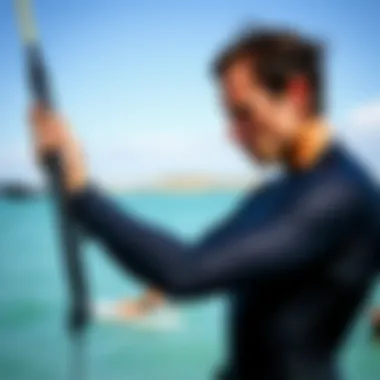
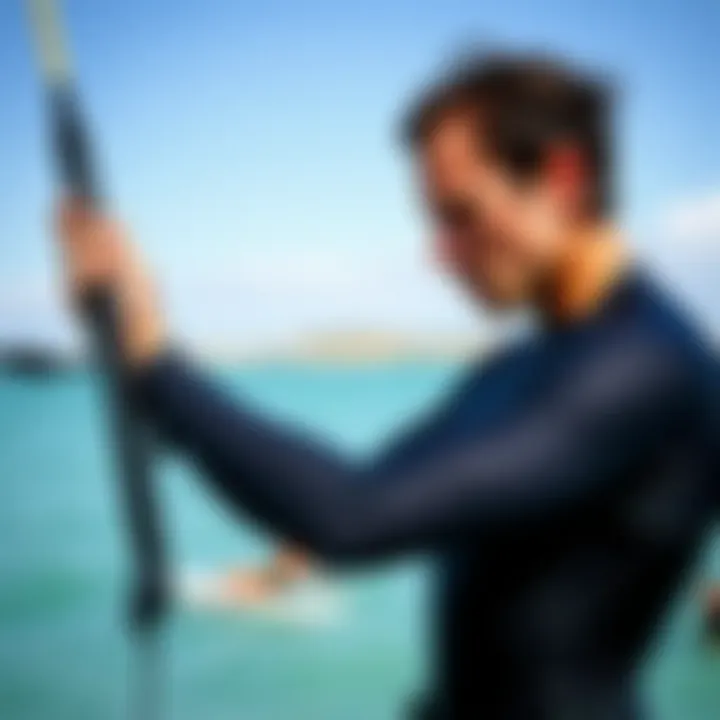
"Accessorizing your wetsuit can transform an average kiteboarding session into an extraordinary experience, allowing you to focus on honing your skills rather than combating the cold."
These accessories can also assist in improving grip for better handling of your kiteboard and provide extra cushioning and support where it’s needed.
By understanding the various types of wetsuits, kiteboarders can make well-informed choices that suit their personal skiing style and environmental conditions. Each type brings unique advantages, ensuring that there is something for everyone, regardless of water temperatures or individual preferences.
Material Selection
When it comes to selecting a wetsuit for kiteboarding, material choice is pivotal—like choosing the right board for the wind. The materials directly influence the suit's flexibility, insulation, and overall durability. Notably, the type of material impacts not just comfort during your ride but also the life span of the wetsuit itself. We'll delve into some key materials, particularly neoprene, as well as a few alternatives that might just catch your eye.
Neoprene: The Common Choice
Neoprene has earned its stripes as the most popular material for wetsuits, particularly among kiteboarders. It’s stretchy, allowing for maximum mobility while you’re maneuvering through the water. But don’t underestimate its protective capabilities—neoprene effectively traps a layer of water, which warms up with your body heat, keeping you cozy during chilly sessions.
A few important properties of neoprene include:
- Insulation: It efficiently retains warmth, keeping you warm in cooler waters.
- Flexibility: The material bends easily with body movements, allowing for an unrestricted experience during rides.
- Durability: High-quality neoprene holds up well against the wear and tear of saltwater and sun exposure.
Nevertheless, not all neoprene is created equal. Thicker suits provide more insulation but might limit mobility slightly, while thinner suits are great for warm weather but can leave you shivering on a brisk day.
Alternative Materials
While neoprene is the go-to, alternative materials are making waves in the world of wetsuits. Some kiteboarders are curious about options such as Yulex and other eco-friendly materials. These serve as alternatives that may appeal to those who are environmentally conscious.
Yulex: This alternative is derived from natural rubber, offering a similar stretch and warmth as neoprene. The key benefits include:
- Eco-friendly: Being biodegradable, it presents a more sustainable choice for the planet.
- Comfort: Many report that Yulex suits are comparable to traditional neoprene in terms of comfort and functionality.
Thermal Liner Materials: Options like Polartec and other thermal linings are being integrated into some wetsuits. These materials help wick away moisture and keep the body warm, enhancing comfort during prolonged sessions in chilly waters.
While these alternatives might not be as mainstream, they offer viable options for kiteboarders looking to stand apart from the crowd and make a eco-conscious statement.
Evaluating Wetsuit Thickness
When it comes to selecting a wetsuit for kiteboarding, one of the most critical factors to consider is the thickness of the wetsuit. The right thickness not only affects your comfort during those chilly morning sessions but also plays a vital role in your overall performance on the water. A wetsuit that’s too thick can lead to overheating, while one that’s too thin may leave you shivering, which can be more than just uncomfortable; it could impact your ability to control the kite efficiently.
Choosing the Right Thickness
Wetsuits generally come in a variety of thicknesses, typically measured in millimeters. For kiteboarding, thickness usually ranges from 2mm to 6mm. When deciding which thickness is right for you, consider the water temperature and air conditions you usually kite in.
- 2mm Thickness: Best suited for warmer waters (above 70°F / 21°C). Offers more flexibility and freedom of movement but may lack the warmth needed for cooler weather.
- 3mm Thickness: A versatile choice that works well in moderately warm to cool waters (between 60°F to 70°F / 16°C to 21°C). It provides a balance of warmth and comfort.
- 4-5mm Thickness: Ideal for colder waters (below 60°F / 16°C). However, with thicker suits, you might sacrifice some range of motion.
- 6mm Thickness: Primarily for extremely cold conditions. This suits the more avid kiteboarder who braves frigid waters but can feel restrictive for movements, so it’s crucial to try it on before purchasing.
It's worth noting that the thickness should align not only with preserved body heat but also with your personal tolerance to cold. A good rule of thumb is to err on the side of comfort; the less time you spend worrying about being cold, the more focus you can devote to your kiting skills.
Weather Conditions and Suit Suitability
Weather conditions play a significant role in determining which wetsuit thickness is suitable for you. If you’re kitesurfing in a place like the Atlantic coast during springtime, expect varying temperatures throughout the day. Early mornings may start crisp while afternoons can feel more like summer. Therefore, being prepared for fluctuating conditions becomes essential.
Consider these factors:
- Water Temperature: Measure the temperature before heading out. Online resources or local surf shops often provide temperature charts and recommendations on wetsuit thickness.
- Air Temperature: If the wind chill factor is significant, even warm waters can leave you feeling cold. This requires a thicker suit or additional layers.
- Wind Speed: High winds can cool you off significantly, regardless of the water temperature. If conditions are windy, opting for a thicker suit can help counteract the chill.
Make sure to test your wetsuit in controlled conditions before heading out for your kiting session. A quick dip can help gauge whether you’ve made the right choice.
Ultimately, choosing the right thickness is about ensuring that you remain warm enough to stay focused on your kiteboarding experience. As unpredictable as Mother Nature can be, being equipped correctly with the right wetsuit thickness allows you to tackle any wave with confidence. Stay warm, stay safe, and enjoy the ride!
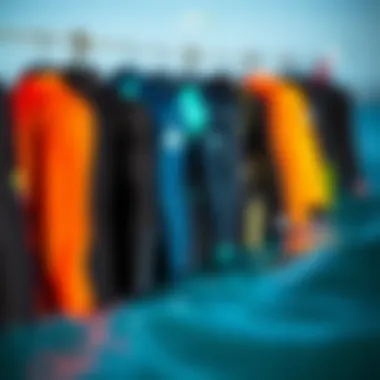
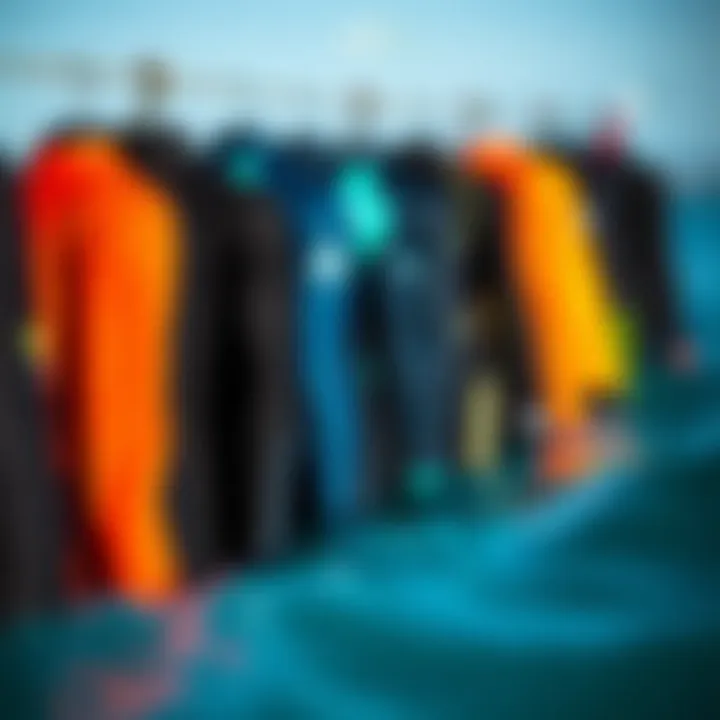
Fit and Comfort
When it comes to kiteboarding, two factors hold the reins: fit and comfort. The selection of a wetsuit isn't just about keeping warm; it directly influences your performance on the water. A suit that fits well enhances your agility, allowing you to maneuver smoothly as you glide over waves. Think of your wetsuit like a second skin�—if it doesn’t embrace your body perfectly, it can hinder movement, making every session feel more like a chore than a thrill.
Understanding Size Options
Selecting the right size involves more than just picking your usual clothing size. Wetsuits are often sized differently. Many brands have specific sizing charts that can be a godsend. It's essential to take your measurements accurately. Key dimensions to keep in mind include chest, waist, hip size, and inseam length.
Here's a quick checklist for determining wetsuit size:
- Measure your chest - Just under your arms, around the widest part.
- Waist measurement - Around your natural waist, while standing.
- Hip size - This is particularly crucial for a good fit in the lower section.
- Height - Some suits rely heavily on your height for that snug fit.
- Weight - This helps with choosing thickness and can guide fit as well.
Once you gather these numbers, compare them against the manufacturer's size guide. Be wary of a suit that is too tight, as it may inhibit circulation and flexibility. Conversely, steer clear of suits that are too loose, which can lead to water pooling inside and sap your body heat. Comfort should be paramount, as any discomfort will divert your focus from enjoying the ride.
Importance of a Snug Fit
A snug fit is where the magic happens. When your wetsuit is properly fitted, it’ll keep you warmer by reducing water flux—less cold water will seep in and embarrass your body’s natural heat. Imagine sliding into a well-tailored suit versus one that’s a size or two too big. The former empowers confidence and capability; the latter, well, it hinders your every move.
Here’s why a snug fit is vital:
- Flexibility and Mobility: The right fit aids in movement. You’ll find your limbs can stretch without restriction, allowing you to reach for the kite's control bars with ease.
- Thermal Efficiency: A snug fit maintains warmth. If your suit fits perfectly, that’s less cold water entering, which means more energy for actually kiteboarding rather than shivering.
- Reduced Drag: An ill-fitting wetsuit can catch the water and create drag, which slows you down. The right size helps with slicing through those waves more effectively.
“A well-fitted wetsuit enhances your performance, elevates your experience, and gives you the confidence to tackle the strongest winds.”
As a kiteboarder, investing time to ensure a snug fit is one of the best choices you can make for your adventures on the water.
In summary, don’t underestimate the importance of fit and comfort in a wetsuit. They are not merely secondary considerations but central to maximizing your kiteboarding experience.
Wetsuit Features
Wetsuit features can make a world of difference in how a kiteboarder experiences the water. Just think about it: you jump onto your board, ready to carve through waves, but if your wetsuit is ill-equipped, you might end up battling against discomfort instead of enjoying the thrill. Proper features not only add to the effectiveness of the wetsuit, but they also ensure that you stay warm, flexible, and confident when taking on that next big wave or gust of wind.
Several elements play a key role in this regard. Some features enhance movement, while others provide insulation or protection. Understanding these elements will allow kiteboarders to select a suit that meets their specific demands and conditions.
Zip Types and Their Impact
When it comes to zippers in wetsuits, they might seem like a minor detail, but their importance cannot be overstated. The type of zipper can affect how easy it is to put on and take off your wetsuit, as well as how water-tight it is.
There are generally three common types of zip configurations for wetsuits:
- Back Zipper: These are the most traditional and often the most affordable option. The zipper runs along the back, which makes it simple to put on. However, this configuration may let in more water, especially if the suit isn’t properly fitted.
- Chest Zipper: Considered an upgrade over back zippers, chest zippers offer a tighter seal against water ingress. This system is often paired with high-stretch materials that enhance movement. One downside is that it can be trickier to put on, but the payoff in performance is usually worth it.
- Zipperless Suits: These suits utilize a unique entry system that does away with the traditional zipper completely. The snug fit helps reduce water entry significantly. Kiteboarders swear by them for their sleek design and comfort, but getting in and out could take a bit of finesse.
It's crucial to consider how frequently you'll be using the wetsuit, where you’ll be riding, and how much water you'll be dealing with. Choosing the right zipper configuration can help make each session smoother and more enjoyable.
Added Features for Enhanced Performance
Beyond zippers, other added features can also boost your wetsuit's performance in significant ways. When out on the waves, every little advantage counts, and technology has come a long way in wetsuit design.
- Sealed Seams: Seams are typically where water might find its way into a wetsuit. Look for seals or stitching techniques like blind stitching or glued seams. These methods not only hold the garment together but also protect you from unnecessary water entry, giving you peace of mind during colder sessions.
- Thermal Lining: Some wetsuits come equipped with thermal linings designed to hold in warmth while retaining flexibility. If you're kiteboarding in cooler temperatures, a suit with this lining will help regulate your body temperature, ensuring that you can stay out longer and perform better.
- Knee Pads: Padding on the knees can be a game-changer. When you're on your board, you might find yourself kneeling more often than not. Reinforced knee pads will provide extra protection against wear and tear, helping prolong the life of your wetsuit.
"Choosing a wetsuit with the right features can often mean the difference between a successful session and one cut short due to discomfort."
Brand Considerations
Choosing a wetsuit isn’t just plucking one off the rack without a thought. When it comes to kiteboarding, the brand you choose often reflects a combination of quality, reputation, and the specific needs of the sport. Brand considerations play a pivotal role in ensuring that what you wear not only offers protection but enhances your performance on the water.
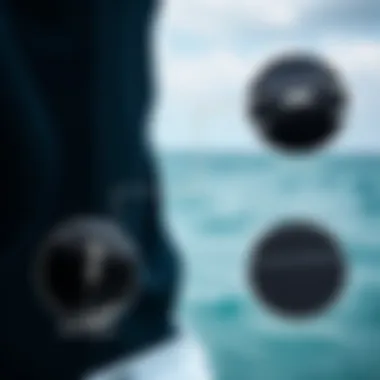
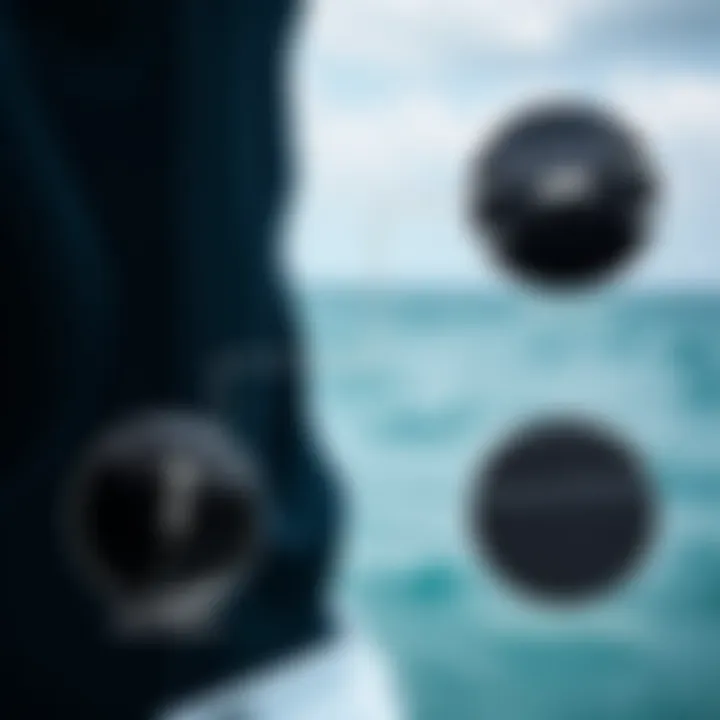
A good brand is like a sturdy foundation in a house. If it’s weak, the whole structure might just tumble. Well-respected brands usually invest in research and development, which means their wetsuits tend to feature cutting-edge technology that can greatly improve your kiteboarding experience. Ultimately, you want to find a brand that resonates with your individual requirements – be it for warmth, flexibility, or durability.
Noteworthy Brands to Consider
When diving into the world of wetsuits, certain brands often stand out. Here are some noteworthy names:
- O'Neill - Known for their range of wetsuits catering to all skill levels, the durability and flexibility they offer makes them a favorite.
- Quiksilver - These wetsuits are designed for those who love style alongside performance. Their products often feature eye-catching designs while maintaining high functionality.
- Rip Curl - Famed for their innovative features like smooth skin and E5 neoprene, Rip Curl suits are built to withstand harsh conditions.
- Billabong - Combining both comfort and performance, their suits utilize advanced materials that can withstand wear and tear.
- Xcel - A go-to for many kiteboarders, their wetsuits tend to provide incredible warmth even in colder conditions.
It’s advantageous to familiarize yourself with these brands and their offerings, as each has established a niche in the market with loyal customers backing them up.
Reputation and Reviews
Before settling on a wetsuit, understanding a brand’s reputation is crucial. The experiences of other kiteboarders can shed light on issues that might not be immediately visible—like zipper quality or the longevity of the materials.
It’s also worth noting that online reviews can be a mixed bag. A critical eye will be beneficial as you sift through the feedback:
- Check platforms like reddit.com or kiteboarding forums to get real-life experiences.
- Look for comprehensive reviews on websites such as britannica.com or industry review sites that specialize in water sports gear.
- Social media platforms often showcase user-generated content where enthusiastic kiteboarders share their thoughts on their gear.
"The real test of a wetsuit isn't just how it performs in the store, but how it holds up after numerous rides in varying conditions."
When reading reviews, pay attention to common themes – if multiple sources mention the same issue, it might be something to consider seriously. A reputable brand, accompanied by positive user feedback, usually assures a worthwhile investment for your kiteboarding sessions.
Maintenance of Your Wetsuit
Caring for your wetsuit is not just about saving an investment; it’s crucial for maintaining the performance and durability you rely on while kiteboarding. A wetsuit, subjected to saltwater, sand, and UV rays, can deteriorate rapidly if not properly maintained. The care routine you adopt can make a world of difference, ensuring your wetsuit continues to keep you warm and comfortable on the water.
Cleaning and Care
Keeping your wetsuit clean is essential. After each use, especially following a day of kiteboarding, it’s beneficial to rinse it off thoroughly. Here’s a step-by-step guide to clean and care for your wetsuit:
- Rinse Immediately: After kiteboarding, rinse your wetsuit with fresh water. Avoid letting seawater or sand accumulate, which can lead to damage.
- Use a Mild Soap: If you’ve been using your wetsuit frequently or it begins to emit odors, you might want to use a wetsuit-specific shampoo. Regular soap can be too harsh.
- Avoid Heat: It’s tempting to speed up the drying process, but avoid placing your wetsuit near direct sunlight or heat sources, as this can warp the material.
- Dry Inside Out: Turn your wetsuit inside out to dry, as this allows the inner parts to ventilate better. Hang it away from direct sunlight to prevent any degradation of the fabric.
- Regular Checks: Keep an eye out for wear and tear, such as seams coming apart or scratches. Small issues can turn into bigger problems if neglected.
Caring for your wetsuit doesn’t just prolong its life; it also preserves its performance. A well-maintained wetsuit provides better insulation and flexibility, making your kiteboarding sessions much more enjoyable.
Storing Your Wetsuit Properly
Once you’ve cleaned your wetsuit, proper storage plays a vital role in its longevity.
- Avoid Folding: Don’t fold your wetsuit; instead, hang it on a sturdy hanger that can support its weight. Folding can create creases and stress points that may lead to tears.
- Cool, Dark Place: Store your wetsuit in a cool, dark area. Excessive heat and light can break down the neoprene over time.
- Avoid Sharp Objects: Make sure your wetsuit is away from anything that could puncture it. Sharp objects can easily lead to tears that can compromise the suit’s integrity.
Proper maintenance and careful storage of your wetsuit are integral for prolonging its life and ensuring optimal performance. A little attention goes a long way!
Ending
Selecting the right wetsuit is not merely a matter of comfort for kiteboarders; it significantly affects performance and safety on the water. A thoughtfully chosen wetsuit enhances your riding experience by ensuring warmth and mobility while also aiding in preventing potential injuries resulting from cold weather or sharp objects beneath the water's surface. This guide has explored the various elements that contribute to making an informed decision, discussing the types of wetsuits, their materials, thickness options, and how a proper fit can shape your kiteboarding outings.
Making an Informed Decision
When it comes to making an informed decision about which wetsuit is right for you, it boils down to a few important factors that relate to individual needs. First, evaluate the climate and water temperature in which you plan to kiteboard. Understanding these factors will help narrow down the types of wetsuits that provide sufficient insulation without hindering movement. Second, appreciate the nuances of fit; a snug yet comfortable wetsuit minimizes water retention while still allowing you the flexibility required for dynamic maneuvers.
Additionally, consider the specific features that may augment your experience. Do you prefer a back zip for ease, or a front zip for better comfort? Furthermore, even the brand reputation can guide your selection process—researching customer reviews can offer real-life insights not often highlighted in product descriptions.
In short, take the time to weigh your options carefully and engage in a bit of trial and error, if necessary, as the right wetsuit can be a game changer in your kiteboarding adventures.
Summary of Key Points
To wrap things up, here are the essential points to remember when selecting a wetsuit for kiteboarding:
- Types of Wetsuits: Understand the differences between full wetsuits, shorties, and spring suits to determine which suits your needs based on the season and water conditions.
- Material Matters: Neoprene is the standard, but alternatives exist. Consider which material offers the right balance of flexibility and warmth.
- Thickness is Key: Choose the appropriate thickness of neoprene based on water temperature to ensure comfort and thermal protection.
- Fit is Crucial: A proper fit allows for freedom of movement and keeps water out, preventing chills.
- Features Count: Look for added features such as reinforced seams or specialized zippers that can impact overall performance and convenience.
- Maintenance: Care for your wetsuit properly to prolong its lifespan and performance.
By reinforcing your knowledge of these factors, you'll be equipped to choose a wetsuit that not only keeps you comfortable in the water, but also enhances your overall kiteboarding experience.















